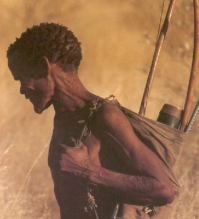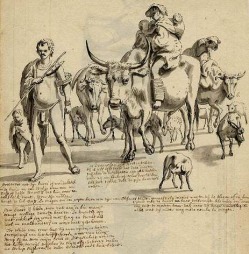Before Imperialism
Herding and Hunting

Archaeological excavations revealed the main source of the Khoikhoi's daily nourishment: meat gathered from hunting and herding (CHNM). Bones of sheep, cattle, and seals from as early as 2,000 years ago noted the coexistence between the two disciplines of herding and hunting (Smith). Professor Andrew Smith of the University of Capetown's Department of Archaeology explains, "when a herder lost stock, through theft, drought, etc. he could always fall back on hunting, and later when he had recouped his losses, would once more become a herder" (Smith).
Driven by their need to find pasture and water for their animals, the Khoikhoi lived a traditional pastoral lifestyle. The Khoikhoi kept large herds of "fat-tailed sheep, long-horned cattle, and goats" (Boonzaier). Their livestock was primarily used for milk, and were only slaughtered during ritual occasions. It was customary for men with no livestock to work as "servants" for wealth livestock owners. In return for tending to the herd, the servants had free access to the milk and usually received payment in the form of a small amount of livestock.
Growing Crops

"The Khoikhoi measured their wealth in livestock—cattle, sheep, and goats" (CHNM). Therefore, those who used the land to farm for a living - those without livestock - were considered to be of a lower socioeconomic status than the Khoikho (Boyce). The farmers were called "Bushmen" and were not as respected and integral members of the Khoikhoi society, since they were not seen as being as successful (Mtyala). The SOS Villages Worldwide Foundation asserts that, "A major part of the population depends on agriculture for its livelihood... largely livestock breeding, especially cattle and sheep" (SOSChildrensVillages.org). Breeding and cattle count are important for a balanced diet, too: "[The] cattle are used also for milk" (TQ).
After Imperialism
Lifestyle

European colonization drove the Khoikhoi people north and west into less productive areas of land forcing most of them to become laborers. Their nomadic lifestyle adapted into a more "settled existence" as their former tribal chiefs became the leaders of villages (Microsoft Online Encyclopedia). Although a small number of Khoikhoi still live a nomadic lifestyle, pastoralism, or the raising of livestock, has become more dominant over hunting. Chiefs control these nomadic tribes which occupy their own territory. Cattle is still the main food source and is also the primary source of trade. Distinction of wealth and prestige within the tribe are attributed to the possession of cattle.
